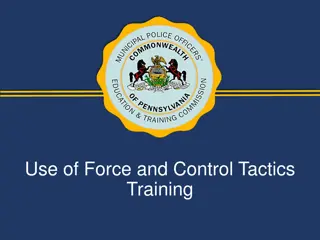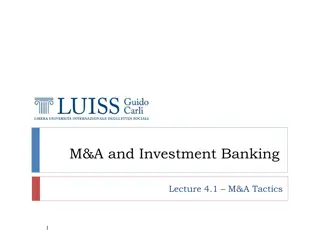Changing Technology, Changing Tactics Lesson by Cameron C. May
Explore the evolution of warfare tactics during WWI with insights on early trenches, barbed wire, rifles, machine guns, grenades, and later trench designs. Witness the impact of technological advancements on military strategies through a series of historical images.
Download Presentation

Please find below an Image/Link to download the presentation.
The content on the website is provided AS IS for your information and personal use only. It may not be sold, licensed, or shared on other websites without obtaining consent from the author.If you encounter any issues during the download, it is possible that the publisher has removed the file from their server.
You are allowed to download the files provided on this website for personal or commercial use, subject to the condition that they are used lawfully. All files are the property of their respective owners.
The content on the website is provided AS IS for your information and personal use only. It may not be sold, licensed, or shared on other websites without obtaining consent from the author.
E N D
Presentation Transcript
CHANGING TECHNOLOGY, CHANGING TACTICS LESSON BY CAMERON C. MAY, NATIONAL WWI MUSEUM AND MEMORIAL TEACHER FELLOW
EARLY TRENCHES GLORIFIED HOLE IN THE GROUND French trench in Champagne, France photo 1976.227.19 (Kansas City, MO: National WWI Museum and Memorial).
BARBED WIRE THINK ABOUT EARLY TRENCHES You have a stretch of open land, with little to no cover, between you and the enemy trench You want to slow the enemy down so you make it REALLY hard for him to get across no man s land Digging trenches and erecting barbed wire photo, 2002.37 (Kansas City, MO: National WWI Museum and Memorial).
RIFLES M 1917 RIFLE WITH BAYONET MAUSER ANTI-TANK RIFLE This rifle will become important when soldiers need to pierce armor to reach their foe. A lot of soldiers carried a bolt action rifle that had a bayonet that could be affixed to the front. With the addition of the stripper clip, soldiers could load multiple bullets at one time to increase rate of fire per minute and cut down on reload time M 1917 Rifle with Bayonette , 1981 003 0078 (Missouri History Museum). Mauser Anti-Tank Rifle (Missouri State Museum).
MACHINE GUNS The improvement on the machine gun allowed soldiers to fire upwards of 500-600 bullets per minute Now think about having only a ditch to protect you and trying to cross a no man s land full of barbed wire to take your opponents trench Look at your trenches and consider the design. The linear design allows for little protection from artillery. You are essentially sitting in a ready-made grave. German light machine gun, MG08/15 (Kansas City, MO: National WWI Museum and Memorial). Maxim MG08 machine gun , no catalog number (Missouri State Museum)
GRENADES As trenches are designed with more fortification and longevity in mind, it becomes harder to get your enemy out of their trench (since they re trying to make the better, too!) WHAT TO DO? Explosive projectiles in the form of grenades and larger artillery guns. Methods of throwing hand grenades from trenches, 1918 photo, 1926.28.384 (Kansas City, MO: National WWI Museum and Memorial). PROPER GRENADE THROWING TECHNIQUE The soldier is protected in his fortified trench while launching an explosive projectile into the enemy trench. Stokes Mortar Round , no catalog number (Carthage, MO: Powers Museum).
LATER TRENCHES Trenches are more refined with fortified walls Walls will stand up to bad weather and avoid the trench becoming a big mud pit Soldiers are protected and basically below the firing line Trench with hurdles and barriers photo, 1976.227.23 (Kansas City, MO: National WWI Museum and Memorial).
GAS MASKS To reach the entrenched enemy, armies used poisonous gas. As this became a threat, gas masks were developed and perfected to protect soldiers. Early gas mask (Kansas City, MO: National WWI Museum and Memorial). Soldier wearing gas mask, pen and ink drawing, 2014.139.6 (Kansas City, MO: National WWI Museum and Memorial). British PH anti-gas tube (helmet) (Kansas City, MO: National WWI Museum and Memorial).
AERIAL VIEW OF TRENCH SYSTEMS IS THIS HOW YOU PICTURED THEM? Trenches at Sofia aerial photo, 1976.227.235 (Kansas City, MO: National WWI Museum and Memorial). Trench lines at Fey-en-Haye, France, aerial photo, 1941.1.41 (Kansas City, MO: National WWI Museum and Memorial).
TRENCH MAP SAMPLE HOW DOES THIS COMPARE TO WHAT YOU DREW AT THE START OF CLASS?
TANKS Now you have a trench protected by barbed wire, machine guns, heavy artillery and designed in a zig-zag pattern. How do you breech the lines? You need something strong, sturdy and impervious to weapons fire. French-made Renault FT17 Tank (Kansas City, MO: National WWI Museum and Memorial). Tank going forward, Battle of the Somme, 1916 photo , 1926.21.2c (Kansas City, MO: National WWI Museum and Memorial).























